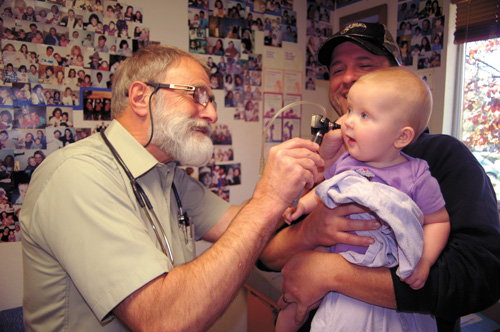
We all know the general rules of staying healthy during the holiday season — wash our hands, cover our coughs and sneezes and stay home from work (and holiday parties) when we’re sick. But what else can we do to give ourselves the best chance of staying happy and healthy during what can be a difficult time of year?
Dr. Richard Mucci says we can do a lot for ourselves during the holiday season by just focusing on maintaining our weight and not going overboard.
“Seventy percent of Americans are either overweight or obese and at this time of year, nobody wants to lose weight, nor is it even practical to consider it,” he said.
The key, he said, is learning how to indulge, but not gain weight.
“You have to keep the idea in mind that food is a joy and pleasure, and it shouldn’t be anything negative.”
But, he said, to help with the struggle that comes when the big meals, tasty desserts and tempting cocktails are served, he has a few tips.
“Taste every single bite. Most of us, after the first two or three bites, aren’t tasting what we are eating, we are just feeding ourselves.”
He adds, “Drink a large glass of water before meals,” and “if you are a dessert freak, and your whole life centers around dessert, you might as well eat dessert first,” so you don’t eat as much in the end, he said.
Dr. Mucci said that while you’re at it, go ahead and make peace with your scale. “Get on it everyday and make it a goal to keep it level within one or two pounds. Accept the fact that there are going to be disruptions and that it’s OK to enjoy the things you enjoy.”
As a reminder, Dr. Mucci said, while we are all talking about overeating, “there are a billion people in the world who are malnourished because of a lack of food. Consider giving time or money to those who are malnourished.”
Dr. Mucci, who has retired from his medical practice and is now in the anti-aging business, is holding a series of classes called “Maintain, Don’t Gain: Holiday indulgence without guilt” in Windsor. The class is held every Tuesday at 5 p.m. and is free at 8911 Lakewood Drive. For more information, call his office 838-4007.
Karen Holbrook, deputy health officer with the County of Sonoma said the number one thing we can do is enjoy ourselves.
“But be prudent about what you eat, by that I mean adding fruits and vegetables in your diet, consume alcohol in moderation and always have a designated driver,” she said.
Holbrook advised adding physical activity into your holiday plans, “taking a walk or hike with the family and consider increasing your exercise routine,” she said.
Holbrook recommended everyone get their flu shots — it’s not too late, she said.
“The flu season cases are still really low in the county and in California. It’s sporadic nationwide.” She said there’s still time to get the vaccine and that it’s hard to predict how bad this year’s flu season will be.
“We are down at low levels, consistent with previous years with the exception of 2010 – the H1N1 epidemic,” she said.
The Centers for Disease Control and Prevention says flu season commonly begins as early as October, peaks in January or February and continues as late as May.
Last year, the flu season began late and was relatively mild compared with previous seasons, accordant to the CDC.
To help combat the spread of the flu virus among elderly and ill patients, the Sonoma County Department of Health Services last month issued a public health order strengthening the requirements for influenza vaccination for health care workers in high risk settings. Workers with patient contact in those settings must now receive an influenza vaccination each fall. If they decline, they must wear a surgical mask during flu season to prevent transmission of flu to patients.
The measure aims to reduce the occurrence of preventable flu deaths in hospitalized or long term care patients.
Also, as part of its larger community health initiatives, Sonoma County has a goal of becoming the healthiest county in California by 2020.
Recently, the county was awarded $3.5 million in federal funding from the U.S. Department of Health and Human Services, and the money will go a long way towards bolstering programs of community health.
Specific projects the money will help fund include:
• Increasing the number of Baby Friendly hospitals;
• More school staff training to integrate physical activity into the school day;
• Expanding the Safe Routes to School program;
• Supporting the local food system by bringing fresh farm produce to schools and providing financial incentives for low-income individuals and families to purchase fresh farm produce;
• Developing nutritional standards for County food;
• Launching a media campaign aimed to reduce the consumption of sugar sweetened beverages and tobacco use;
• Conducting training for youth in suicide prevention; and conducting training in healthy community design for planners, policy makers, and architects.
“By focusing on where people live, work, learn, and play, this grant will improve the health of many individuals, contribute to our vibrant community, and help build the environment and systems needed for everyone to live healthier lives. This new funding will help the County’s commitment to being the healthiest County in California by 2020, guided by the leadership and vision of Health Action,” said Sonoma County Director of Health Services Rita Scardaci.
Health Action is a local, community wide council focused on improving community health and has launched programs including the iWalk, iGrow and iCare initiatives.
For more information about the county public health initiatives, go to www.sonoma-county.org/health. The web site also has a link to a searchable database with locations for flu shots.







